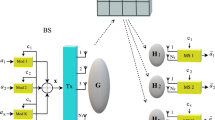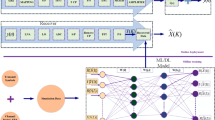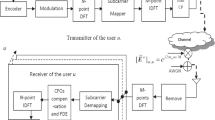Abstract
In this paper, we propose an efficient uplink and downlink cooperative transmission and receiving scheme for interleave-division multiple access (IDMA) systems with time-reversal (TR) technique. We refer this system as TDR-IDMA, since the time- division duplexing (TDD) mode is used in this transceiver system. In TDR-IDMA systems, the time-reversed version of the channel impulse responses obtained from the uplink is used to process the received signal before the elementary signal estimator in the receiver of base station (BS). Due to the weak correlations of multi-path for different users, the signal to interference and noise ratio (SINR) at the beginning of turbo-like detection of TDR-IDMA can be increased significantly. Compared with conventional IDMA system, much less iterations is needed for signal detection in TDR-IDMA systems. Thus, the proposed scheme effectively reduces the multi-user detection (MUD) computation load for the uplink, which is the bottleneck for IDMA system. TR processing is also applied in the transmitter of BS to reduce the complexity of user ends (UEs). Simulation and analysis results show that TDR-IDMA can achieve the same performance of the traditional IDMA system with fast processing speed and simple UEs.
Similar content being viewed by others
References
Fink M. (1992) Time reversal of ultrasonic fields. I. Basic principles. IEEE Transactions on Ultrasonics, Ferroelectrics and Frequency Control 39(5): 555–566
Jin, Y., Jiang, Y., & Moura, J. M. F. (2007). Multiple antenna time reversal transmissions in ultra-wideband communications. In 50th globe communications conference, Globecom’ 07, Washington, DC, November pp. 26–30.
Manolakis D. G., Ingle V. K., Kogon S. M. (2000) Statistical and adaptive signal processing. McGraw-Hill, Columbus
Moura J. M. F., Jin Y. (2007) Detection by time reversal: Single antenna. IEEE Transactions on Signal Processing 55(1): 187–201
Moura J. M. F., Jin Y. (2008) Time reversal imaging by adaptive interference canceling. IEEE Transactions on Signal Processing 56(1): 233–247
Oestges C., Kim A., Papanicoloaou G., Paulraj A. J. (2005) Characterization of space-time focusing in time-reversed random fields. IEEE Transactions Antennas and Propagation 53: 283–293
Parsons J. D. (2000) The mobile radio propagation channel (2nd ed.). Wiley, New York
Ping L., Liu L., Wu K., Leung W.K. (2006) Interleave-Division Multiple-Access. IEEE Transactions on Wireless Communication 5(4): 938–947
Ping, L., Wang, P., & Wang, X. (2007). Recent progress in interleave-division multiple-access (IDMA), In Invited paper, Military communication conference (MILCOM), Orlando, Florida, USA, October, pp. 29–31.
Qiu, R. C., Zhou, C., Guo, N., & Zhang, J. Q. (2006). Time reversal with MISO for ultrawideband communications: Experimental results. IEEE Antennas and Wireless Propagation Letters, 5.
Rouseff D., Jackson D. R., Fox W. L. J., Jones C. D., Ritcey J. A., Dowling D. R. (2001) Underwater acoustic communication by passive-phase conjugation: Theory and experimental results. IEEE Journal of Oceanic Engineering 26(4): 821–831
Schoeneich, H., & Hoeher, P. A. (2005). Semi-blind pilot-layer aided channel estimation with emphasis on interleave-division multiple access systems. IEEE GlobeCom, pp. 3513–3517.
Vucetic B., Yua J. (2003) Space-time coding. Wiley, New York
Author information
Authors and Affiliations
Corresponding author
Rights and permissions
About this article
Cite this article
Xiong, XZ., Hu, JH. & Ling, X. A Cooperative Transmission and Receiving Scheme for IDMA with Time-Reversal Technique. Wireless Pers Commun 58, 637–656 (2011). https://doi.org/10.1007/s11277-009-9898-6
Published:
Issue Date:
DOI: https://doi.org/10.1007/s11277-009-9898-6




